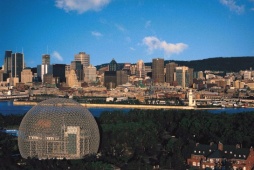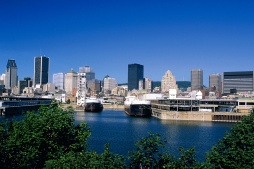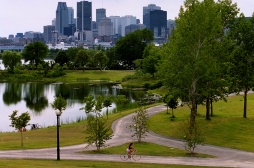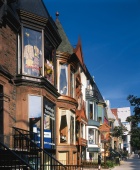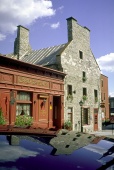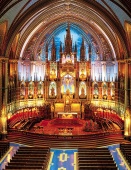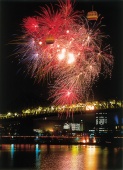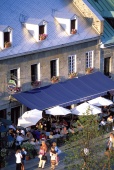
|
|||||||||||||||||||||

|
|||||||||||||||||||||
Montréal, Quebec, Canada
|

|
||||||||||||||||||||
Besides that, Montreal is a warm and relaxed city with great nightlife, cultural highlights and a very European touch. Even though all signs are in French by law, you will get around with English only pretty well. Store, restaurant or service personnel is used to address customers in the language they prefer. Montreal offers an ethnic diversity, blending cultures from around the world, resulting in vibrant residential districts like Plateau Mount-Royal, Chinatown and Little Italy, among others. Cultural delights include the Montreal Symphony Orchestra, one of the world's finest and most recorded, 18th and 19th-century architecture and a fantastic dining scene with more than 5,000 restaurants. Montreal's "Underground City" links shops, dining establishments, museums and hotels and allows you to tour the city without ever having to put on a coat. Montreal is a very safe and friendly metropolitan city with a first-class transit system that makes it easy for visitors to get around. Don't miss Notre-Dame Basilica, Pointe-à-Callière National Historic Site, and Bonsecours Market while in Montreal. Even though temperatures are moderate in other seasons, it can be cold in winter with piles of snow. That's the perfect time for tobogganing and ice skating adventures on Mont Royal or cross-country skiing at Parc Maisonneuve. Fête-des-Neiges is a very popular winter festival as there are many other festivals and events throughout the year. Montreal in Figures
Montreal island encompasses 27 municipalities of which the City of Montreal itself is the largest. There are about 4,000 restaurants in town. Temperatures in winter can drop as far as - 40 degree Celsius. Arrival Montreal is accessible by air, train and road. There are two airports that serve Montreal - Dorval International, which is situated 14 miles west of downtown and Mirabel International, which is located 34 miles northeast of downtown. Almost all passenger flights go from Dorval International Airport while Mirabel handles mainly charters and cargo. Please be aware that Dorval Airport charges a $10 beautification tax when you arrive or depart. For more information on both airports go to website. There are two train stations in the downtown area of Montreal. The main CN-VIA Rail station, often referred to as Central Station (Gare Centrale), is located on the corner of Boulevard René Lévesque and Rue Mansfield. VIA Rail offers service to Toronto, Ottawa and Quebec City. Amtrak's Adirondack links New York and Montreal on a daily schedule. Local commuter trains start at Windsor Station, located a few blocks from Central Station at the corner of Rue Peel and Rue de la Gauchetière. Both stations are linked by the underground city. You can walk from one to the other in 10 minutes. Both stations can be reached by metro. Use Bonaventure station. For more information on VIA Rail go to their website. For more information on Amtrak go to to their website. If you drive to Montreal by car you can either use the Trans-Canada-Highway that runs right through the city or Hwy 15 that runs south to the United States or Hwy 401 that connects Montreal to Toronto and beyond westward. Distances Ottawa 190 km Quebec City 270 km Toronto 539 km Bus travelers can reach Montreal by various bus companies such as Voyageur lines, Orléans Express, Greyhound and smaller regional companies that connect numerous other cities within Quebec, the rest of Canada and the United States. All buses start at the Station Centrale, at the corner of Rue Berri and Boulevard de Maisonneuve. The station can be reached by metro. Use the Berri-UQAM station. For more information call the bus station at 514-842-2281 Traveling within Montreal Public Transportation The city of Montreal offers an excellent public transit system served by the STCUM (Société des transports de la Communauté urbaine de Montréal). Besides the subway system there are about 140 bus routes and two major commuter train lines. Please be aware that the metro lines shut down around 12:30 a.m.! There are however about 20 all-night bus routes that run until around 5:30 a.m. The metro is a safe, clean and fast way to get around. Lines run from east to west and from north to south intersecting at Berri-UQAM station. Stations are indicated by large blue signs with a white arrow pointing down. For more information go to see our website. Bicycles
Climate Montreal's climate varies a lot over the year. The city is known for its cold winters, but its summers are hot and generally sunny, with occasional muggy days. Average temperatures vary from 10-25F (-13C-5C) in January to 65-80F (18C-27C) in July. Health and Safety In case of an emergency call 911 for ambulance, fire or police. For non-emergency police matters, dial 514-280-2222. Montreal has a low crime rate. Nonetheless it is a large city and you should remain normally vigilant about your possessions and your person. No particular area of the city is marked off as dangerous, but it is not recommended to wander around Mont Royal or other large parks alone at night. The Metro is safe at all times. Parks and protected areas Lachine Canal National Historic Site  The Lachine Canal stretches 14.5 km from downtown Montréal through Lake Saint-Louis to Lachine. The Lachine Canal was built in 1825 as a means of bypassing the Lachine Rapids on the St. Lawrence River. Today, Lachine Canal National Historic Site offers a 14 km bicycle and pedestrian pathway, many picnic areas and open green spaces to enjoy. Subway: Square-Victoria, Lionel-Groulx and Charlevoix, the latter station is only 100 m from the site. For more information call (514) 283-6054. Parc de la Promenade Bellerive Parc de la Promenade Bellerive is a 2.2 km long park that offers an outstanding panorama view of the St. Lawrence River. This park is very lively in summer and is the location for many performances such as dancing, concerts and outdoor theatre. It is also departure point for a river shuttle between Îles-de-Boucherville and various cruises. Subway: Honoré-Beaugrand For more information call (514) 493-1967. Mount Royal Park Mount Royal is a very special part of Montréal's heritage. Its landscapes, flora, fauna and history make it an exceptional place to visit. Splendid Mount Royal Park was founded in 1876 and is an ideal site for admiring a wide variety of plants and birds. The trails provide you with enjoyable walking and cycling adventures. Subway: Mont-Royal For more information call (514) 843-8240. Montréal Botanical Garden  Open 365 days a year, the Montréal Botanical Garden is the place to visit in any season. The Montréal Botanical Garden, located just minutes from downtown Montréal, right near the Biodôme and Olympic Park, offers a world of colors and fragrances for visitors to enjoy. Ranked as one of the largest of its kind in the world, the Montréal Botanical Garden is a veritable living museum of plants from the four corners of the Earth. Subway: Pie-IX For more information call (514) 872-1400. Things to do Markets & Shopping
Bonsecours Market  This original Old Montreal Farmer's Market is located at 350 Rue Saint Paul Est. (Nearest Metro Station: Champ-de-Mars). The Bonsecours Market, which was inaugurated in 1847, was built according to the plans of architect William Footner. This jewel was Montreal's main agricultural marketplace for over a century, before it served as concert hall and even as a city hall. The renovations undertaken in 1996 and 1997 have rekindled some of the character and functionality of yesteryear and have recreated a permanent site for Montrealers to meet and interact together. For more information call (514) 872-7730. Underground City Montreal's Underground City, as a matter of fact the largest in the world makes shopping convenient even in harsh winter conditions, Montreal is known for. Almost 12 square kilometres between Mount Royal to he north and the Saint-Lawrence River to the south, complete with access to hotels, restaurants, movie theatres, shopping and office buildings, make up this city under the city. There are 30 kilometres of underground corridors and of course the Metro. The tourist office provides maps. Historic Sites Bank of Montréal Located at 119 Saint-Jacques Street West (Nearest Metro Station: Place-d'Armes). The Bank of Montréal was founded in 1817 and is the oldest banking institution in Canada. The head office, dating back to 1847, offers an imposing facade. The building was redesigned in 1905. The lavish interior echoes the success of the Bank of Montréal. The Bank of Montréal Museum is open for visitors. For more information call (514) 877-6892. Montréal City Hall  Located at 275 Notre-Dame Street East (Nearest Metro Station: Champ-de-Mars). Montréal City Hall has a more turbulent history than its peaceful façade suggests. The building went up between 1872 and 1878, and survived a severe fire in 1922. And it was from this balcony that French President General de Gaulle uttered his famous "Vive le Québec libre !" (Long Live Free Québec) during a state visit in 1967. Take a moment to admire the Hall of Honour or, better yet, sign up for a guided tour. For more information call (514) 872-3355. Old Customs House Located at 150 Saint-Paul Street West (Nearest Metro Station: Place-d'Armes). The Old Customs House, built between 1836 and 1838, was one of the first architectural elements to attest to the British presence in Montréal. This neo-classic building was designed by John Ostell, architect, engineer and surveyor. The house is now an integral part of the Pointe-à-Callière, Montréal Museum of Archaeology and History.
Saint-Sulpice Seminary Located at 130 Notre-Dame Street West (Nearest Metro Station: Place-d'Armes). Saint-Sulpice Seminary (Vieux Séminaire) was erected between 1684 and 1687 and is the oldest building in Montreal. 20 years later, the building was extended by Messrs of Saint-Sulpice who ran the Notre-Dame parish and were seigneurs of the island of Montréal for nearly two centuries. This striking historical structure, a true symbol of continuity, is a prime example of the institutional architecture in New France. Its clock that dates back to 1701, would be the oldest of its kind in North America. Sir George-Étienne Cartier National Historic Site  Located at 458 Notre-Dame Street East (Nearest Metro Station: Champ-de-Mars). This interactive museum commemorates the life and times of Sir George-Étienne Cartier, one of the Fathers of Confederation. The Sir George-Étienne Cartier National Historic Site is the reconstitution of the two adjoining homes of the Cartier family. The site provides an insight of the upper middle class of 19th-century Montréal. For more information call (514) 283-2282 or toll-free at 1-800-463-6769. Fur Trade National Historic Site  Located at 1255 Saint-Joseph Blvd., Lachine (Nearest Metro Station: Angrignon, Bus 195 West). The Fur Trade National Historic Site is located west of the Island of Montreal along Lake Saint-Louis. The old stone warehouse, dating from 1803, was built by Alexander Gordon of the North West Company to store trading goods and furs. In 1833, the warehouse became the property of the Hudson's Bay Company. Today, this unique warehouse houses interactive presentations and self-guided or guided tours that allow visitors to better understand this industry so essential to the colony's growth. For more information call (514) 637-7433. Fort Chambly National Historic Site  Located at 2 De Richelieu Street, Chambly. Fort Chambly National Historic Site is located on the banks of the Richelieu River, at the foot of the Chambly Rapids. This French fortification, dating back from 1711, is an invaluable witness to the French presence in North America. It was built in order to prevent the British army from reaching Montréal. Restored in 1983, the fort presents today numerous artefacts, remains and exhibits relating to the history of New France. For more information call (450) 658-1585. Churches Christ Church Cathedral Located at 635 Sainte-Catherine Street West (Nearest Metro Station: McGill). Christ Church Cathedral was built between 1857 and 1859 and marks a fine example of neo-gothic architecture. A fine tracker-action organ, built by Karl Wilhelm in 1980, attracts organists and music lovers from many places, as does the music programme of the Cathedral. For more information call (514) 843-6577.
Saint Joseph's Oratory  Located at 3800 Queen-Mary Road (Nearest Metro Station: Côte-des-Neiges). Saint Joseph's Oratory atop Mount Royal is an impressive modern-style basilica and one of the world's most visited shrines. Saint Joseph's Oratory was completed in 1960 and features a huge dome that reaches 97 metres. For more information call (514) 733-8211. Other attractions Molson Centre Located at 1255 Saint-Joseph Blvd., Lachine (Nearest Metro Station: Angrignon, Bus 195 West). Learn all about the world's most famous hockey team, the Montréal Canadiens, in Molson Centre! See glorious memorabilia, tour the building and discover history. Molson Centre is one of the largest and most sophisticated sports, entertainment and meeting complexes in the world. For more information call (514) 925-5656 or toll-free 1 800 363-3723. McGill University Located at 805 Sherbrooke Street West (Nearest Metro Station: McGill). McGill University, founded by James McGill, a Montréal fur trader born in Glasgow, is one of Canada's most prestigious universities. Situated at the foot of the mountain, McGill University is worth a stroll. The downtown campus comprises more than 80 buildings on 80 acres of land. For more information call (514) 398-6555. Canadian Centre for Architecture Located at 1920 Baile Street (Nearest Metro Station: Atwater / Guy-Concordia). The Centre Canadien d'Architecture/ Canadian Centre for Architecture is a world acclaimed museum and study centre devoted to the art of architecture past and present. It is praised for the richness of its collections and the quality of its exhibitions. The awarded design of the CCA building integrates the historic monument Shaughnessy House of 1874. Don't miss the magnificent sculpture garden! For more information call (514) 939-7026. Centre d'histoire de Montréal  Located at 335 Place d'Youville (Nearest Metro Station: Square-Victoria / Place-d'Armes). Experience the history of Montreal in the entirely renovated Centre d'histoire de Montréal with a total of 16,000 sq. ft. of exhibition space. The Centre d'histoire de Montréal offers a unique and original insight of the city of Montreal, it's historical, architectural, social and cultural history. For more information call (514) 872-3207. Montréal Museum of Archaeology and History & Pointe-à-Callière National Historic Site  Located at 350 Place Royale (Nearest Metro Station: Place-d'Armes). Pointe-à-Callière, National Historic Site is a major attraction in the historic quarter of Old Montréal. The museum has three main sections: the Éperon building, a modern structure set on the ruins of older buildings; the archaeological crypt in the basement; and the renovated Old Customs House. Self-guided tours let the visitor discover the museum at his own pace. Interpreter-guides are stationed at different points on the tour route and will be happy to answer any questions. For more information call (514) 872-9150. Montréal Biodôme  Located at 4777 Pierre-De Coubertin Avenue (Nearest Metro Station: Viau). The Montréal Biodôme is an oasis in the heart of Montreal and recreates some of the most beautiful ecosystems of the Americas. Inside this environmental museum you can view rocky landscapes, tumbling waterfalls and majestic trees including birds, mammals and fish that fly, climb and swim through their natural habitats. Showcased are the polar world, the tropical and the Laurentian forests as well as the Saint-Laurentian marine environment. For more information call (514) 868-3000. Montreal Olympic Park  Located at 4141 Pierre-De Coubertin Avenue (Nearest Metro Station: Viau). Montreal Olympic Park was built for the 1976 Summer Olympic Games. The showpiece is the multipurpose Olympic Stadium designed by the French architect Roger Taillibert. It is impressive in size and shape and is able to hold 80,000 spectators. The tower marks the world's tallest inclined tower. Olympic Stadium is used for major sport events, rock concerts and other mass gatherings. For more information call (514) 252-8687 Entertainment
Les Grands Ballets Canadiens de Montréal Located at 4816 Rivard Street (Nearest Metro Station: Laurier). Shows take place at: Place des Arts 175 Sainte-Catherine Street West. Founded in 1957 by Ludmilla Chiriaelf, Les Grands Ballets Canadiens de Montréal play a major role in the diffusion and development of ballet in Montreal and elsewhere in the country. In terms of diffusion, the company produces four shows annually in Montreal. Throughout its season, it also welcomes internationally known companies to Montreal like The José Limòn Dance Company, the Warsaw Ballet, and Sweden's Cullberg Ballet. For more information call (514) 849-8681. Orchestre symphonique de Montréal Located at 260 de Maisonneuve Blvd. West (Nearest Metro Station: Place-des-Arts). Orchestre symphonique de Montréal is one of the most prestigious orchestras in the world, offering approximately a hundred concerts per year. Concerts take place at Salle Wilfrid-Pelletier of Place des Arts and at the Notre-Dame Basilica in the heart of Old Montréal. For more information call (514) 842-3402. L'Opéra de Montréal Located at 260 de Maisonneuve Blvd. West (Nearest Metro Station: Place-des-Arts). L'Opéra de Montréal was founded by the Ministère des Affaires Culturelles du Québec on January 30, 1980, and is today ranked among the 15 most important opera companies in North America. Performance of traditional and contemporary operas at Place des Arts. For more information call (514) 985-2222. Festivals and Events
Blue Metropolis Montreal International Literary Festival, April 3-7, 2002 18e Journées du cinéma africain et créole film festival, April 19-27, 2002 May 7th Annual Jewish Film Festival May 9-16, 2002 Montreal Bike Fest May 26-June 2, 2002 Le Mondial de la bière Beer Festival May 29-June 2, 2002 June Tour de l'Île bicycle race, June 2, 2002 Nuit blanche sur tableau noir, June 6-9, 2002 Montreal First People's Festival June 10-20, 2002 Le Grand Prix du Canada - Formula One, June 7-9, 2002 International fireworks competition, June 15-July 28, 2002 Fête nationale, June 23 and 24 - parade and events Festival international de Lanaudière classical music festival, June 28-August 5, 2002 Montreal International Jazz Festival, June 27-July 7, 2002 July Canada Day, July 1 - parade and events International fireworks competition, June 15-July 28, 2002 Festival international de Lanaudière classical music festival, June 28-August 5, 2002 Montreal International Jazz Festival, June 27-July 7, 2002 Comedy festival Just for laughs/Juste pour rire, July 11-21, 2002 Music Festival Nuits d'Afrique, July 11-21 2002 Dragon Boat Race Festival, July 20 and 21, 2002 Les FrancoFolies, July 25-August 3, 2002 Divers/Cité Gay and Lesbian Pride days, July 28-August 4, 2002 August St-Jean-sur-Richelieu Hot Air Balloon Festival, August 10-18, 2002 Montreal International Film Festival, August 22-September 2,2002 Dining
Most restaurants get busy around 8 pm and stay that way for a couple of hours. Reservations are recommended at this time. If you prefer to eat earlier, you may have the entire place to yourself. The central area of downtown offers various places to eat. Old Montreal is a charming place, popular with tourists. Prices tend to be a little higher and are generally posted outside. The location and restaurant décor usually is worth a try. The Main, Boulevard Saint Laurent just south of Rue Sainte Catherine is known for one of Quebec's treats - hot dogs, better known as steamies. Don't miss to try one! If you want to try it the original way, simply ask for 'all dress' and you will get a hot dog garnished with relish, mustard, onion and topped with chopped cabbage. Montreal's small Chinatown, between Rue Saint Urbain and Boulevard Saint Laurent, offers mainly Cantonese cuisine. History
This little French town was home to some 600 colonists by 1685, dominated by the parish church and the seminary of the Sulpician fathers, seigneurs of the Island. It soon became a fur-trading centre where Montrealers and First Nations would meet to trade. There were regular attacks by the Native Indians and Montreal became more and more a military base secured by a wooden palisade. In 1701, the war was put to an end, when the Great Peace Treaty of Montréal was signed with a large number of First Nations. The fur trade boomed. In 1713, the Treaty of Utrecht ended the war between France and England. Montreal was under French control until 1760, when the British captured it. Settlers were to follow. The rebelling American colonies were after the city and General Montgomery took Montreal in 1775 without firing at shot. When the British beat back the Americans in Quebec City, the revolutionaries fled Montreal. In the early 19th century, Montreal became the political and commercial hub of Upper and Lower Canada. Its population, increased by waves of English, Scottish and Irish immigrants, rose from 10,000 in 1800 to about 50,000 in 1850. By 1870, Montreal had transformed into an industrialized metropolis with mushrooming factories that produced large working-class neighborhoods. All produced items were shipped by rail or sea throughout Canada and the rest of the world. The old city center still reflects some of the prosperous times. By 1900 Montreal was Canada's commercial and cultural centre. In 1965, Old Montreal was declared a historic district. Montreal was home to the Expo 67 and the Summer Olympics in 1976. |
|||||||||||||||||||||
Other province's Travel Tips
|
|||||||||||||||||||||
